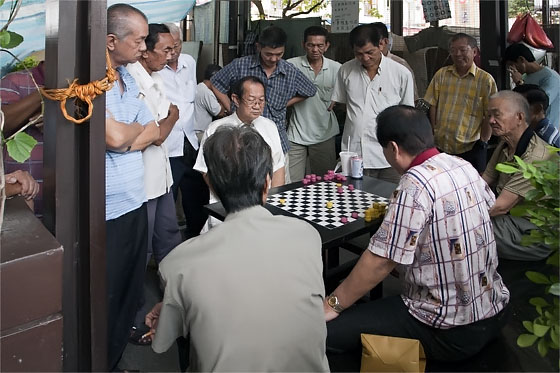Things To Do In Singapore
Introduction
Locals and the Singapore Tourist Authority will tell you there are many things to do in Singapore. For the average visitor who is there for a few days on a stopover this is true. Choices about what to do and see will need to be made as there won't be enough time to do everything.
For the long term resident though it doesn't take very long to see everything and many expats complain of 'island fever' which results in frequent trips to neighbouring countries to escape the close confines of the island. My experience with most of the things to see in Singapore is that once is enough and after that they get a bit boring. It is not like going to one of the major museums in London where there is just too much to see in one trip and different things can be seen on repeated visits.
Many of the man-made attractions in Singapore remind me of a Disney'esque type theme park. Indeed one commentator described Singapore as being like "Disneyland with the death penalty". If I went to the Epcot Center in Florida and was wandering around 'Singapore Land', that is, a Disney'ised sterile clean version of life in Southeast Asia, that is what much of Singapore reminds me of.
On my last couple of trips I have taken to just jumping on buses and going wherever the bus takes me. My objective has been to see some examples of real life on the island rather than the packaged theme parks that the government wants tourists to see. Seeing at first hand the large HDB blocks and locals going about their everyday lives tells me more about the island than walking around Sentosa for half a day.
An alternative is to do the same thing on the MRT. Once outside the central business district the MRT is above ground and is a good vantage point to see Singapore. Because the island is so small it doesn't take long and it isn't expensive.
Sentosa Island
 This is Singapore's premier pleasure facility. It is a small island on the south side of Singapore and very close. It can be reached by causeway, boat or cable car. On my visits I have always gone by cable car. It's high up and makes me feel a little queasy but gives excellent views. There is a great view of the port, an important part of Singapore's economy, from up there.
This is Singapore's premier pleasure facility. It is a small island on the south side of Singapore and very close. It can be reached by causeway, boat or cable car. On my visits I have always gone by cable car. It's high up and makes me feel a little queasy but gives excellent views. There is a great view of the port, an important part of Singapore's economy, from up there.
There are hotels and a golf course on Sentosa as well as an aquarium, butterfly park, nature walks and other such attractions. There are some beaches and a few even smaller islands nearby. A monorail goes around the island continuously and it is free to ride with the price of admission. Sometimes there is a long wait though and when the train arrives there may not be any available seats so you have to wait for it to go round again.
Sentosa is the venue for Singapore's big New Year party where the local girls get into their bikinis and head for a big foam party. Although I've been in Singapore before for New Year I've never participated.
Jurong Bird Park
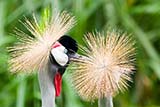 If you like birds this is a good place to visit with over 8,000 birds and various organised shows taking place every day. It's not just tropical birds either, the penguin house (a large refrigerator) is very good. It is also the home to the world's tallest man-made waterfall.
If you like birds this is a good place to visit with over 8,000 birds and various organised shows taking place every day. It's not just tropical birds either, the penguin house (a large refrigerator) is very good. It is also the home to the world's tallest man-made waterfall.
Jurong bird park is world-class in every sense. There aren't many places in the world where you can view as many species of bird as you can here. The best displays are the walk-in aviaries where you aren't looking at birds through cages.
It's way out West. Getting there by public transport requires taking the MRT to Boon Lay, the Westernmost station on the system and then catching a bus but this is all very well organised and easy to do.
Jurong Reptile Park
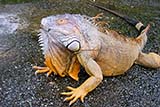 The reptile park is located just across the car park from the bird park. It's not that impressive but worth a look if you haven't got anything better to do. There are some very large crocodiles and some smaller ones that can be held for photographs (with their snouts sellotaped shut I hasten to add).
The reptile park is located just across the car park from the bird park. It's not that impressive but worth a look if you haven't got anything better to do. There are some very large crocodiles and some smaller ones that can be held for photographs (with their snouts sellotaped shut I hasten to add).
I liked the iguana area where you can view iguanas up close with no cages or glass in between. They don't bite but apparently if they get upset they may whip you with their tails.
On my last visit in April 2006 the reptile park was not looking good. It is privately owned, unlike the world-famous bird park across the carpark which is state owned. Very few exhibits were open and two staff were trying to run the whole place.
It was in the process of being liquidated with the hope that maybe some new owners might step in. For all I know, it may be closed by now. If you visit the bird park and then go to the reptile park, expect a very different experience.
Singapore Zoological Gardens
In recent years I have started to have a few problems with zoos. I think they are vital for the work they do with the protection of endangered species but watching animals who are used to having all the freedom they want pacing up and down in a confined area is quite sad. Seeing large birds of prey who would normally cover thousands of square miles being kept in small cages where there isn't even enough room to fly is especially sad.
The Singapore zoo, like everything else in Singapore, is supposed to be state-of-the-art and futuristic but conditions for the animals are still far from ideal.
Night Safari
I believe that when this first opened it was quite unique but now other countries, including Malaysia, have similar attractions. Malaysia never likes to be outdone by its arch enemy. It's actually very good and somewhere that should feature high up on visitors' lists of things to do while in Singapore.
The idea is simple. It's a zoo that opens at night. Geographically, close to the equator, Singapore is ideally positioned for such an attraction as dusk comes quite early and is fairly consistent throughout the year. This idea might not work very well in Scandinavia where it doesn't get dark until very late (or not at all) in the summer months.
The Night Safari features animals which are nocturnal or which are active at night. Low level lighting allows visitors to see what is going on. Torches (flashlights) and flash photography are not allowed. A pseudo train (no rails) ferries people around to different parts of the park.
It is not only the animals being exhibited that are active. The local mosquitoes and other biting insects are too so cover up or apply plenty of insect repellent.
Chinatown
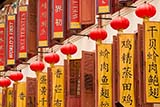 The original Chinatown area was bulldozed in the early 60's. This is no exaggeration. In the Singapore National Archives are photographs of the bulldozers going in and completely levelling the area. A nice, clean 'Disney' type Chinatown was built in its place.
The original Chinatown area was bulldozed in the early 60's. This is no exaggeration. In the Singapore National Archives are photographs of the bulldozers going in and completely levelling the area. A nice, clean 'Disney' type Chinatown was built in its place.
At first I thought this was very sad. How could Singapore destroy their own heritage like that without any thought about preservation? What I didn't realise though was how much of a slum the original area was and that the only way to make it suitable for human habitation was to start again.
Years later I went to the Chinatown area of KL where the Malaysians have taken a different approach. Rather than demolish the slum building they have been left to stand but the area has just been 'tarted up' by putting a roof above the street and planting a few palm trees. When I saw this I knew that Singapore had gone about it the right way.
Chinatown now is just a massive tourist trap. It is also quite puzzling why an island where over three-quarters of the population is Chinese has a Chinatown at all but it does. This is where all the tourists go and where the parasites who feed off tourists by cheating them also go. I have started to hate the place. Whenever I get that false friendliness from a local Chinese who is trying to work out the easiest way to extract money from me as if I am a Southeast Asia virgin I just want to hit him. They can hold their hands out as much as they like to shake mine but I just walk past.
Chinatown Heritage Centre
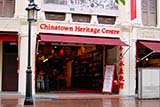 This is worth seeing. Migration from China in the 19th century and later was quite fascinating. To escape abject poverty and extreme living conditions the Chinese migrated to all parts of the globe where they have been masters at assimilating into local communities and doing very well in business. That initial journey from China to wherever they were headed was not an easy journey though.
This is worth seeing. Migration from China in the 19th century and later was quite fascinating. To escape abject poverty and extreme living conditions the Chinese migrated to all parts of the globe where they have been masters at assimilating into local communities and doing very well in business. That initial journey from China to wherever they were headed was not an easy journey though.
The museum charts the history of this Chinese migration. The ships coming from China were so crowded that people could not sit or lie down. They were forced to stand due to lack of space. Sometimes the journey took months. Those who got sick or died on the journey were just thrown overboard. All this is illustrated in the museum.
When they arrived it wasn't much easier. Many were forced into bonded labour or found work for very little salary, just enough to survive on. Opium dens and prostitution were big problems in the Chinese communities.
The museum presents a graphic picture of life for these early settlers. The actual building is three old shophouses right in the middle of Chinatown. The best part of the tour comes right at the end. In the last section the curators have recreated actual living cubicles. At first I thought they must have been original because they look so authentic but they aren't. Apparently they were built with the help of people who actually lived in such accommodation so the detail is very accurate.
What is staggering is how many people there were in the families that lived in these tiny spaces. It is well worth a visit and now there is an MRT station close by - Chinatown on the North-East line.
Chinese And Japanese Gardens
Not a particularly exciting place to visit but quite tranquil and there are some good views if you climb the pagoda there. Unfortunately the Japanese Gardens were closed for renovation when I went and I imagine I would find Japanese style gardens more attractive than Chinese style ones.
Has its own MRT station (Chinese Garden, on the East-West line) so easy to get to. Because it is quite a peaceful place with few people around keep your eyes open for local wildlife. I saw some good size lizards and some very attractive birds. In the ponds that are part of the gardens are hundreds of turtles, some quite large.
Raffles Hotel
Named after Sir Stamford Raffles, the founder of modern day Singapore, it was an institution in Singapore but has now become a parody of itself and a massive tourist attraction. It is a lovely, whitewashed building and very pleasing on the eye. The Long Bar was where the famous Singapore Sling was invented.
I always wanted to go but on my first visit to Singapore in 1990 it was closed for major renovations. I went on a later visit and it was disappointing. My idealised notion of Raffles was like stepping back in time to the colonial era. There would be a polite, efficient barman mixing cocktails and chatting congenially.
It's not like that at all though. Everyone and his dog goes to Raffles for a Singapore Sling. The cocktails are not mixed individually but mass produced and poured from huge containers. For what they are they are very expensive. Tourists wander around constantly and loud Americans sit there drinking overpriced cocktails thinking they are unique, exotic travellers not realising that the whole thing is a cliche and tourist trap.
There is a nice Indian restaurant at Raffles in the Tiffin Room (hearing that always reminds me of Sid James in Carry on up the Khyber). It's a buffet but the food and service is excellent.
Clarke Quay
This is tourist and expat central and it wouldn't bother me if I never saw the place again. The quay used to be a working quay but commerce was removed from the Singapore River many years ago. It's just an expensive eating and drinking venue now. There are bars where the expat bankers hang out and several restaurants where they tout incessantly for business to every passer-by.
I find it expensive and boring. It's just not for me but obviously suits a lot of people.
Haw Par Villa
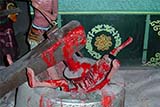 Originally known as Tiger Balm Gardens, this attraction was created and donated to Singapore by the two wealthy brothers who invented and sold Tiger Balm. Their names were Aw Boon Haw and Aw Boon Par. The theme is Chinese folklore, proverbs and mythology. If you can imagine a Chinese version of Aesop's Fables then this is roughly what it is.
Originally known as Tiger Balm Gardens, this attraction was created and donated to Singapore by the two wealthy brothers who invented and sold Tiger Balm. Their names were Aw Boon Haw and Aw Boon Par. The theme is Chinese folklore, proverbs and mythology. If you can imagine a Chinese version of Aesop's Fables then this is roughly what it is.
The Ten Courts Of Hell at Haw Par Villa is an interesting, if somewhat gory exhibit. This is a Chinese version of judgment after death with some rather horrific punishments inflicted for various crimes and misdemeanours during life. Small models are used to show the punishments and there is no shortage of blood.
The following is a list of sins committed in life with the appropriate punishments that are meted out after death.
Sin
Punishment
Gambling or prostitution
Disrespect
Drug addiction and trafficking
Lack of filial piety
Plotting against others for their property
Cheating and swearing
Wasting food and misuse of books
Raping and instigating suicide
Cheating in examinations
Harming others
Neglect of old and young
Some of the punishments are a bit harsh, don't you think? Body dismembered and intestines pulled out for cheating in exams. If that's true there will be a lot of very worried Thai school kids.
Bukit Timah Nature Reserve
 The signs at the nature reserve indicate that a lot of wildlife is present and I'm sure it is but you will need to be lucky to see anything. I saw a few monkeys and that was about it. I am quite wary of monkeys these days since being attacked by one in Langkawi but Singaporean monkeys understand that there are severe punishments for that kind of thing here so they were all well behaved.
The signs at the nature reserve indicate that a lot of wildlife is present and I'm sure it is but you will need to be lucky to see anything. I saw a few monkeys and that was about it. I am quite wary of monkeys these days since being attacked by one in Langkawi but Singaporean monkeys understand that there are severe punishments for that kind of thing here so they were all well behaved.
The trails are quite steep and walking around there was the most exercise I'd ever had in Singapore. There is a small visitor centre which contains exhibits of what can be found at the nature reserve and there are staff on hand to give advice and guidance.
Changi Chapel Museum
For me the fascination of Singapore is not what it is now but what it was a short time ago and how it has transformed itself. During World War Two the island was occupied by the Japanese Imperial Army and this occupation was quite brutal. The Chinese were singled out for particularly harsh treatment but British, Australian and other Allied soldiers also suffered.
Changi prison was used to incarcerate many prisoners of war. The chapel and small museum there has photos and artefacts from that bleak period in Singapore's history. It is a sombre experience but an interesting one. When I went I was the youngest person there, I guess because the older generation are normally more aware about recent history. There were a lot of Australians and I would hazard a guess that they probably had parents who served in Singapore and suffered at the hands of the Japanese.
Battle Box At Fort Canning
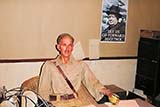 This is another interesting place with regard to Singapore's recent history. It is an underground bunker that was used as the operations room for Allied forces during World War Two and where the order was given to surrender Singapore to the Japanese.
This is another interesting place with regard to Singapore's recent history. It is an underground bunker that was used as the operations room for Allied forces during World War Two and where the order was given to surrender Singapore to the Japanese.
Inside there are waxwork models of the British generals and commanders in charge at the time and a recording reenacting meetings that took place. The person in charge of the museum is an Indian gent who has a keen interest in the events that took place during that time. I knew a little and he was happy to chat for a considerable time about tactical errors that allowed the Japanese to take Singapore so easily.
National Archives Of Singapore
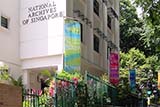 You may or may not have noticed while reading through these pages that I find Singapore's recent history (in the last 60 years or so) more interesting than present-day Singapore. The National Archives is a good place for getting more information about Singapore's past. Around the walls are photos of the island how it used to be when Orchard Road wasn't much more than a dusty track and prone to frequent flooding.
You may or may not have noticed while reading through these pages that I find Singapore's recent history (in the last 60 years or so) more interesting than present-day Singapore. The National Archives is a good place for getting more information about Singapore's past. Around the walls are photos of the island how it used to be when Orchard Road wasn't much more than a dusty track and prone to frequent flooding.
There is also a reference library but I was unable to use it on my only visit to the Archives as it was closed for stock taking.
Geylang
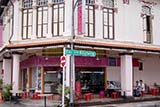 Geylang is not an 'attraction' but just an area of Singapore. It has a seedy side but nonetheless it is an area I find quite interesting in otherwise sterile Singapore. If people want to experience a Chinese neighbourhood I think they are better off going to Geylang than to Chinatown. Chinatown is for the tourists but Geylang is where real Chinese life takes place.
Geylang is not an 'attraction' but just an area of Singapore. It has a seedy side but nonetheless it is an area I find quite interesting in otherwise sterile Singapore. If people want to experience a Chinese neighbourhood I think they are better off going to Geylang than to Chinatown. Chinatown is for the tourists but Geylang is where real Chinese life takes place.
There are Chinese restaurants, shops, places of worship and the clan associations for the different dialect groups - Hokkien, Hakka, Teochew, etc. The different dialect groups have different cuisines so restaurants serve quite different food depending on which group of Chinese owns them.
I am not keen on authentic Chinese food even though I enjoy the Anglicised version of Chinese food served in the UK. In some restaurants are small fish tanks containing lime green frogs ready for the pot. Other places advertise mutton brain and mutton balls while various parts of pigs normally thrown away in the Western world are considered delicacies - the ears, head and intestines, for example.
Geylang has many prostitutes, many of them Thai, so there are a few cheap Thai restaurants where you can find tom yum goong and khao phad, etc. As I said, it's a little bit seedy but it's not dangerous and I find it quite colourful. Orchard Road with all its designer labels bores me rigid but I'm happy wandering around Geylang.
Pulau Ubin
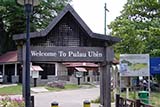 Pulau Ubin is a small island off the north-east coast of Singapore, probably closer to Malaysia than it is to Singapore, but in Singapore's territory. Nature and wildlife is protected on the island and it is a pleasant place to go for a half-day trip. The pace of life on Ubin is a lot slower than it is in Singapore.
Pulau Ubin is a small island off the north-east coast of Singapore, probably closer to Malaysia than it is to Singapore, but in Singapore's territory. Nature and wildlife is protected on the island and it is a pleasant place to go for a half-day trip. The pace of life on Ubin is a lot slower than it is in Singapore.
The main mode of transport for visitors is bicycle and these can be rented from any one of several shops near the jetty. Rental costs are not expensive but it still pays to ask at a few places. The shop nearest the jetty gets the first opportunity to grab new arrivals and rent them a bike but charges more than the other places.
Coconut palms line the road but, this being ultra-efficient Singapore, the coconuts above the road have been cut off to prevent them falling on to the head of a cyclist. There is nowhere else in Southeast Asia where this would happen.
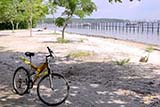 As I mentioned before, wildlife is protected and the local wildlife includes 100 or more wild boars. On my last visit to Ubin I was happily cycling along when I heard some rustling in the bushes ahead of me. I stopped and just as I did so a huge boar came charging out of the undergrowth, ran across the road and disappeared into the forest on the other side. If I had not stopped I would probably have been broad sided by the huge beast.
As I mentioned before, wildlife is protected and the local wildlife includes 100 or more wild boars. On my last visit to Ubin I was happily cycling along when I heard some rustling in the bushes ahead of me. I stopped and just as I did so a huge boar came charging out of the undergrowth, ran across the road and disappeared into the forest on the other side. If I had not stopped I would probably have been broad sided by the huge beast.
Snakes and reptiles also get protected status but I have never seen a snake there. They are shy creatures and try to avoid humans. There are some very attractive tropical birds flying around if you keep your eyes open but on my visits I have heard more birds than I've seen.
To get there take the MRT to Tanah Merah, take a bus to Changi Village and then get on a bum-boat to reach Ubin. The bum-boat fare is 2 SGD but they only leave when they have a full quota of 12 passengers.
Little India
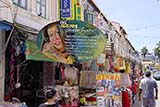 Indians represent a significant proportion of Singapore's population and have their own area, Little India. It's a colourful neighbourhood and should be on every first-time visitor's list of things to see. In addition to being colourful to look at, a walk around Little India can simulate the other senses as well.
Indians represent a significant proportion of Singapore's population and have their own area, Little India. It's a colourful neighbourhood and should be on every first-time visitor's list of things to see. In addition to being colourful to look at, a walk around Little India can simulate the other senses as well.
Wailing Indian music is played in every shop and a rather pleasant scent fills the air as you walk past the shop that uses large machines to grind spices. Saris and other Indian clothing are on sale as are Indian books and magazines. Posters advertising Bollywood films with demure Indian actresses and grinning, mustachioed Indian film stars are everywhere.
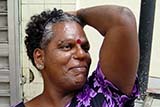 Of course, this is the place to get Indian food and there are lots of restaurants. Some are quite basic - this isn't Chutney Mary's in Chelsea. The basic places serve your food on a banana leaf from large buckets and you are expected to eat with your fingers, with the help of some nan bread to mop up the juices. A speciality is fish head curry which isn't actually as bad as it sounds.
Of course, this is the place to get Indian food and there are lots of restaurants. Some are quite basic - this isn't Chutney Mary's in Chelsea. The basic places serve your food on a banana leaf from large buckets and you are expected to eat with your fingers, with the help of some nan bread to mop up the juices. A speciality is fish head curry which isn't actually as bad as it sounds.
For the curious there is an 'interesting' little road that runs parallel to Desker Road in Little India. It's where the budget end of Singapore's red-light industry takes place and the sights are pretty amazing.
How the women operating there manage to drum up any business is a mystery to me but obviously they must otherwise they wouldn't be there. For the tourist who is fed up looking at designer shops on Orchard Road it makes an interesting excursion.
For your viewing pleasure I have included a picture of one of the beauties who can be found in this neighbourhood. I have doubts now though whether she was a woman, despite the fact 'she' had a dress on.
Golden Mile Complex - Little Thailand
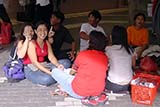 The Golden Mile Complex isn't advertised as Little Thailand but that's what it is in reality. There is a sizeable Thai population in Singapore (mostly working girls operating in Geylang and Orchard Towers unfortunately) and the GMC is their little piece of home. It is also home to many travel agencies and the place to go for getting a bus up into Malaysia or Thailand.
The Golden Mile Complex isn't advertised as Little Thailand but that's what it is in reality. There is a sizeable Thai population in Singapore (mostly working girls operating in Geylang and Orchard Towers unfortunately) and the GMC is their little piece of home. It is also home to many travel agencies and the place to go for getting a bus up into Malaysia or Thailand.
I like mooching around here. I don't find Singaporeans particularly friendly but Thais are friendly wherever you go. There are Thai shops, bars and restaurants with Thais doing what they do best - eating, drinking, talking, joking, laughing. The Thais have fun while the Chinese Singaporeans in the travel agencies work hard to get more business. So typical.
Last time I was there I got chatting to a group of Thais who, typically, were sitting on the floor with a big pile of Thai food in the middle and the men in the group were passing round a bottle of whisky. They invited me to join them, as Thais do. After walking around on my own for days being ignored by the Singaporeans it was nice to meet some friendly people.
Lucky Plaza On A Sunday
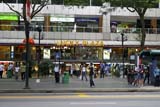 Singapore is full of little ethnic groups. Singaporeans are very keen to describe themselves as a multi-racial, multi-cultural society who all live in perfect harmony, and to some extent this is true. Race riots in the early 60's almost tore Singapore apart so it is very important for Singapore to prevent and discourage any racial tension.
Singapore is full of little ethnic groups. Singaporeans are very keen to describe themselves as a multi-racial, multi-cultural society who all live in perfect harmony, and to some extent this is true. Race riots in the early 60's almost tore Singapore apart so it is very important for Singapore to prevent and discourage any racial tension.
However, the picture painted by Singapore of everyone living happily together isn't altogether accurate. I have never detected any real conflict between races in Singapore but what is noticeable is how all the ethnic groups stick together and don't really mix. They mix in business, where they have to, but given the choice they stick with their own kind.
For a small island with a relatively small population (approx. 4.4 million) there is a disproportionately high number of domestic maids working in Singapore. They come mainly from the Philippines and Indonesia. I can't remember the figure but it is something like 150,000 maids.
Some don't get a day off but if they do it is on a Sunday and the Filipina maids like to congregate at Lucky Plaza on Orchard Road. Despite the fact they earn a pittance and send most of their earnings back to their families they still like to have a good time on their day off. Sunday afternoon is their Saturday night.
I've been along a few times and it is good fun. The girls are nice people and really friendly. Some are highly educated but because of economic conditions at home have been forced to do menial work abroad to earn money. They meet their friends, shop, and there are some Karaoke bars where they can sing along in Tagalog.
There are places where they can make cheap phone calls to the Philippines or send parcels home. There are also a number of maid agencies on the upper floors which actually are quite pathetic. It's almost like the slave trade. Pictures of the girls are displayed with details of the 'skills' they have been trained in. These include carrying heavy objects, washing clothes, mopping floors, cooking and being able to hang out clothes on the poles that are used in HDB flats.
The girls don't seem to have chips on their shoulders about this though and some of the friendliest encounters I have had in Singapore have been with Filipina maids.
Yet another story about maid abuse in Singapore appeared in December 2005 following a report by Human Rights Watch (HRW). This is a recurring subject.
Labour laws that apply to other workers do not apply to maids. They work for a pittance and are not entitled to any time off by law. The ones lucky enough to work for foreign expats and decent Singaporeans get treated fairly and are given time off. Some are treated like members of the family. The less fortunate ones are treated like slaves. Some are abused. Maids have been murdered, raped and some commit suicide.
Many apartments and condominiums in Singapore include maid's quarters. More often that not this is a tiny room little larger than a cupboard without a window. One argument in favour of employing so many maids is that at least it gives them employment. Without this employment they would be back in the Philippines, or whatever, struggling to survive.
I don't see a problem with employing maids but I think they should at least have some rights. Days off, sensible working hours, appropriate accommodation and food, and a fair wage shouldn't be things left to the discretion of their individual employers.
Sunset At Swissotel The Stamford
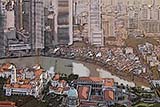 This hotel is one of the tallest in Asia.
This hotel is one of the tallest in Asia.
There is a bar and restaurant at the top that offers magnificent views of Singapore. The thing to do is get there at about 5:30pm for daylight views and while you are sipping on a cocktail take in the views while the sun is setting and Singapore starts to light up.
There is no better view of Singapore. The hotel is located very close to City Hall MRT station. The views are all from behind glass unfortunately. If you want to take photos, use a polarising filter to reduce reflections from the glass. At dusk the light is low and exposure times long so a tripod is useful too.
Sunday Brunch
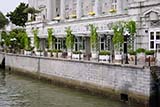 Very popular with the expatriate community. All of Singapore's large hotels offer a Sunday brunch and it actually represents very good value, but make sure you are very hungry before you arrive in order to make the most of the food on offer. They normally start at around 11am and finish around 2pm. The format is simply a huge, fixed-price buffet. Two prices are normally available, one with and one without Champagne. The bottles of Champagne are unlimited if chosen.
Very popular with the expatriate community. All of Singapore's large hotels offer a Sunday brunch and it actually represents very good value, but make sure you are very hungry before you arrive in order to make the most of the food on offer. They normally start at around 11am and finish around 2pm. The format is simply a huge, fixed-price buffet. Two prices are normally available, one with and one without Champagne. The bottles of Champagne are unlimited if chosen.
At most of the hotels the food is quite sumptuous and varied. For one course you can eat sushi or other Japanese food and then follow this up with a traditional English roast dinner. Choice of venue is a personal thing. The picture is of the Fullerton, once Singapore's main Post Office but now a luxury hotel. The interior here is very light and spacious and it is possible to wander outside by the river.
Festivals
Singapore loves any excuse for a party or festival and because of the diverse ethnic mix on the island these occur almost every month. In quite a short space of time you can witness Deepavali (the Indian festival of lights), Christmas, the Christian New Year, Chinese New Year and then maybe something like Thaipusam. The accompanying photo was taken at Thaipusam.
I can't give dates because many of the Indian and Chinese festivals use lunar dates which fall on different calendar days each year. Try to find out before or just after you arrive. The Christmas festivities are centred around Orchard Road while Chinese Year, as would be expected, is mainly celebrated in Chinatown. With such a large Chinese population it's a big thing in Singapore.
Singapore Botanic Gardens
The Botanic Gardens are another nice escape from city life and traffic in Singapore. It is a very tranquil setting with a huge selection of flora. There is an artificial lake containing large fish and turtles. Contained within the Botanic Gardens are the National Orchid Gardens.
Entrance is free to the Botanic Gardens but a charge is made to see the Orchid Gardens. It is within walking distance of Orchard Road although a taxi or bus (numbers 7, 106, 174) might be more convenient.
Buddha Tooth Relic Temple and Museum
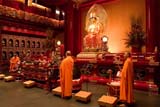 Located in the Chinatown area, this is a large and very beautiful Buddhist Pure Land temple which is claimed to house a Buddha Tooth Relic.
Located in the Chinatown area, this is a large and very beautiful Buddhist Pure Land temple which is claimed to house a Buddha Tooth Relic.
The closest MRT stations are Chinatown, Outram Park and Tanjong Pagar. If you triangulate these three stations that will be almost exactly where the temple is.
The exterior and interior of the building are really beautiful and there is a fabulous roof garden which is tranquil and relaxing. The museum on the third level of the temple is devoted to Buddhist culture and contains Budhist artefacts and pieces of Buddhist art.
Whatever your religious convictions - and even if you don't have any - this temple is certainly worth a visit if you find yourself in Singapore.
The temple is open to visitors every day from 7am to 7pm, including public holidays. It is a sacred place so dress appropriately. Rather fetching sarongs and shawls can be borrowed if you arrive wearing clothing that is too revealing for a Buddhist temple.
You can find more information at the official Buddha Tooth Relic Temple and Museum web site.
E-mail: services@btrts.org.sg
Address: 288 South Bridge Road, Singapore, 058840
Tel: +65 6220 0220
Fax: +65 6220 1261
Get The Best Deal On Your Singapore Hotel Room
Listed opposite are some suggestions for hotels in Singapore based on budget. Each link will take you to the relevant page on the Agoda website where you can see photos, read reviews, and book on-line. I use Agoda to book all of my own hotels in Thailand and the Southeast Asia region. Agoda hotel rates are usually always the lowest and I have received good customer service, therefore I am happy to recommend the company to other people.

Images of Thailand
Top End
Mid Range
Chinatown
Budget Hotels
Backpacker Accommodation

